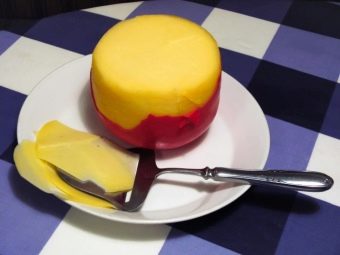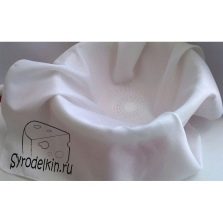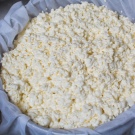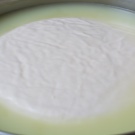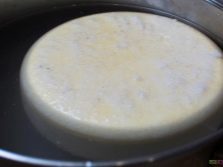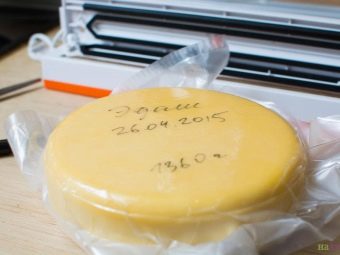Edam Cheese: Calorie, Nutrition & Cooking Recipes

The most popular variety of Dutch cheese is "Edam".Cheese production began in a small town in North Holland several centuries ago. The second name of the cheese - "Edamer." Today it is considered a very popular dairy product, which is loved by domestic buyers.
General characteristics of the variety
This product is hard and semi-hard cheeses. The percentage of fat does not exceed 45%. The main component from which Dutch cheese is prepared is high quality cow's milk.
By the natural fermentation process, the required curd mass is formed. Then this mass is placed in a container in which it is sent under a press. Using this method, the serum is separated. The next step - the resulting product is sent for drying, after which it is waiting for salting - this happens by rubbing the cheese head with salt. Finally a cheese ball is placed in the cooked pickle.
According to the standard cooking technology, cheese should mature for at least 18 weeks. During the period of maturation, the product should be properly, carefully taken care of, pour salt, cleaned with special brushes. For a long time, cheese-makers began to use a black wax coat as a coating. This feature emphasizes the identity of the elite varieties of "Edam". In addition, there is a "normal" view, covered with paraffin yellow or red film.
Gourmets call the taste of this variety piquant, with obvious nutty notes. In Holland cheese dairy products are presented in two forms - young and mature (aged). Young cheese has a sweet and delicate flavor, with a slight hint of spiciness. Mature has a drier consistency and a pronounced salty taste.
Interestingly, the characteristic drawings on the head of the "Edamer" is not observed. Eyes come in different sizes and shapes, and their absence does not indicate poor quality or disturbances in the preparation of the product. This "Edam", made from high-quality cow's milk, has a homogeneous consistency. The color can vary from white to pale golden tones.
It is acceptable to use natural dyes, for example, shrub seeds, to paint cheese heads. To give a special piquancy allows apple juice.
The recipe for making cheese "Edam" at home
As ingredients, you will need leaven and enzymes. It is better to buy milk in specialized dairy stores, where the quality of the product is beyond doubt. The pledge of delicious cheese is in the freshness of milk.
For the correct process you need to use special tools. These include scales for food, form, press, napkins, thermometer and waxed film. The rule is to do everything with clean hands or with disposable gloves. Dust or foreign bodies are not allowed in the serum. Any misstep - and all the ingredients will be released.
A detailed description of the preparation.
- Heat pasteurized milk to 32 degrees. Calcium and leaven are added.
- Then the enzyme is added. Here you need to be careful with the portion, since most of the enzyme will be bitter. After half an hour, you need to cut the resulting clot into several pieces and leave it for 5 minutes. Crayons pieces talk about the hardness of the future product. For the preparation of soft varieties suitable large pieces or not at all touched.
- We should not forget about stirring the mass, bringing it to 34 degrees.
- After that, the excess serum is poured into the pan. On average should get about 5 liters. Add hot water (about 50-60 degrees) and wait for the curd to reach 70 degrees.
- Continuous stirring continues. It is necessary to obtain a dense curd. It takes about 30 minutes.
- The curd mass is laid in a colander and covered with gauze.
- Put on top of a 5-pound load.
- Heat the serum to 48 degrees. Take out the cheese and place it in a heated milky liquid directly into the tissue. Press the 15-kilogram press.
- Turn and press down with a press of 20 kg. The duration of the procedure is 9 hours.
- Prepare the brine with the addition of whey and salt. Cheese is dipped into it.
- To dry the product should be in a cold place for about 4 days.
The next step will be the dairy product aging. Cheese requires a constant temperature of 14 degrees and a stable level of humidity - not less than 75 and not more than 85%. But if you covered the cheese ball with paraffin or placed in a vacuum, you can ignore the moisture indicators. Under the film cover, a special environment is created that is favorable for the ripening of the cheese product.
The minimum term of ripening is 2 months. Longer exposure gives the cheese a rich and spicy taste. Therefore, the duration of exposure depends on your taste preferences.
Strictly following the recipe of cooking this sort of Dutch cheese, you can surprise your family with a delicious and natural homemade product. And you don’t have to worry about the quality of the product at all, since only fresh and natural ingredients were used in the cooking process.
Calorie and composition
The nutritional value of 100 grams of product is about 330 calories. Among them - 24 g of protein, 26 g of fat and 0 g of carbohydrates. The energy ratio of protein, fat and carbohydrates (BJU) is as follows - 29: 70: 0.
The benefits of cheese are due to the constituent vitamins and minerals that the human body needs. The daily intake of dairy product for children is 100 grams, for adults - 150-200 grams.
The composition of vitamins is as follows:
- beta carotene;
- vitamin A;
- vitamin E;
- vitamin D;
- vitamin group B (B1, B2, B3, B4, B5, B6, B9, B12);
- vitamin D3;
- vitamin K;
- vitamin c
Mineral composition:
- magnesium;
- phosphorus;
- iron;
- calcium;
- potassium;
- sodium;
- zinc;
- copper;
- manganese;
- selenium.
Reviews
Many buyers note that cheese bought is sometimes bitter. Someone writes off this factor on the expiration date. In fact, the bitter taste is a frequent occurrence in Dutch cheese. This feature is characteristic of low-heat rennet cheeses. Substance and bitterness can be introduced into milk.
In addition, it is possible to change the taste of the composition of fresh milk. It depends on what feed the cow ate. Wormwood, buttercup, colza, field mustard, lupine add bitterness.
“Edamer”, like all semi-hard cheeses, has a smooth and oily consistency, so the question of whether it melts or not is answered this way: the structure allows them to melt well. Therefore, they are often used for cooking in the oven. The dish is evenly covered with baked cheese crust, which gives a special taste and aroma. Dutch cheeses are used in recipes for pizza, pasta, salads, side dishes, casseroles, and pies. Often added in a grated form.
Real gourmets will truly appreciate the unusual taste of Dutch cheese. Affordable price allows you to use it more often than, for example, soft cheeses.
An important factor - the availability of almost every store. When buying a product, pay attention to the cheese heads, their appearance and smell, as well as their shelf life. Well, if you want to feel like an experienced Dutch cheese-maker, then you should definitely try to cook the cheese according to the homemade recipe strictly according to the rules. Surely the family will be proud and enjoy its wonderful taste.
How to choose the best Edam cheese from the range presented in Russia, see in the video below.





